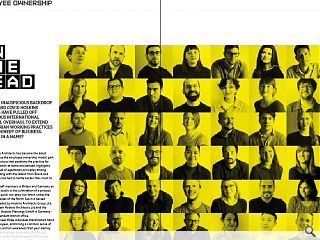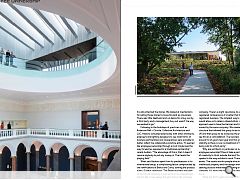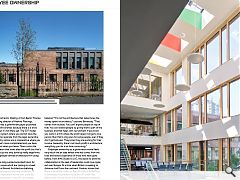Employee Ownership: In the Lead
26 Oct 2022
Against an inauspicious backdrop of Brexit and Covid Hoskins Architects have pulled off an audacious international structural overhaul to extend its egalitarian working practices to the machinery of business. But what’s in a name?
News that Hoskins Architects has become the latest practice to embrace the employee ownership model, part of a general restructure that positions the practice for a new phase of growth at home and abroad, highlights the enduring appeal of egalitarian principles among architects. Coinciding with the fallout from Brexit and Covid the practice has had to battle harder than most to make it happen.
Giving all 48 staff members in Britain and Germany an equal stake in the studio is the culmination of a process that has not been quick, nor easy, but which unites the business on both sides of the North Sea in a nested legal structure headed by Hoskins Architects Group Ltd, sole owner of Gareth Hoskins Architects Ltd and the newly established Hoskins Planungs GmbH in Germany - formerly an independent branch office
The transition sees three individual shareholders hand control to all employees, enshrining a common sense of belonging, fairness and an awareness that your destiny now lies in your hands alone. Explaining the thought process behind the switch to an Employee Ownership Trust (EOT) finance director Jennifer Guillain told Urban Realm: “We tragically lost Gareth in 2016 and after that, his wife inherited the shares. We looked at mechanisms for selling those shares to move forward as a business. There was little likelihood and no desire for a buy-out by a third party and a management buy-out wasn’t the way we wanted to go.”
Following in the footsteps of practices such as Anderson Bell + Christie, Collective Architecture and LUC, Hoskins consulted extensively with other architects, engineers and lighting designers to see what forms of business partnerships and cooperatives were possible to better reflect the collaborative practice ethos. “It seemed like employee ownership through a trust model was the way forward as opposed to a traditional partnership”, recalls Guillain. “The advantage of this is that it doesn’t require anybody to put any money in. That levels the playing field.”
What sets Hoskins apart from its predecessors is its international setup, a complicating factor compounded by the ramifications of Brexit and Covid, slowing the process down. Guillain continued: “The Berlin business was part of the UK Ltd company, it was set up as an independent branch. But it was always the plan that as the company grew it would separate into a Gmbh, a German Ltd company. There’s a slight reluctance to appoint UK-registered companies so it’s better that it’s a German-registered business. The simplest way to do this, which would allow us to retain a shared ethos, ownership and approach was to have the German and UK subsidiaries owned by the same company. We created a simple group structure that allowed the group to be registered in the UK and that group to be owned by the employees. We see this as a consolidation. The business will have been around for 25 years next year and this gives a sense of stability as there is now no likelihood of the business being sold to a third party.”
Why are architects in particular so ready to embrace employee ownership? Does it take a particular strain of creativity to think outside the box? Guillain said: “It speaks to the way architects work. There are no tangible assets. The assets are the people who work there, the intellectual property and the design work. You aren’t seeking outside investment or looking to sell to another company. It’s about the value of the people who work there.”
While the EOT system has taken off in the UK the situation in Germany remains very different, owing to a variety of legal constraints. Dialling in from Berlin Thomas Bernatzky, founding director of Hoskins Planungs, explained: “There was a government paper published on employee benefit schemes because there is a drive to employ more but it’s not there yet. The EOT model is not possible in a system where you cannot have the beneficial ownership separate from the legal ownership. In Germany, the only option was a cooperative where you own shares but that’s more complicated and you have to buy in or are paid when you leave. There is also the option of a foundation that looks after the profit but that’s complicated to set up and only done by really large firms. We’re the only employee-owned architecture firm using that model.”
Architects have long worked extended hours for relatively low pay, issues which are coming to a head now with workers at Atomik Architecture balloting on strike action over pay and working conditions. If successful it could represent the first ever strike by private architectural workers in the UK. Is a change in ownership structure enough to redress imbalances at a time when we are all reconsidering our work-life balance? “It’s not the architecture that determines the money spent on architects,” cautions Bernatzky. “That comes from outside. You can’t exploit people on top of that. You can reward people by giving them a part of the business and that helps with recruitment. If you know you work in a firm where the profit doesn’t all go to one person then that’s a big plus for some people, even if they don’t get bonuses. They know they are working for their income. Generally, there’s not much profit in architecture, everything you do is so time-consuming.”
Employee ownership as a governance model feels very much like an idea whose time has come, from the tried and tested experience of those who have gone before, from AMA Studio to LUC, the desire to enshrine collaboration at the seat of leadership could now ripple out over Europe. At a time when Britain is seeking to distance itself from the continent, Hoskins shows that there is more that unites us than divides us. In the face of adversity, the practice has pulled off a feat that likely could not and would not be attempted today but which positions the business for a new era of borderless opportunities.
|
|





